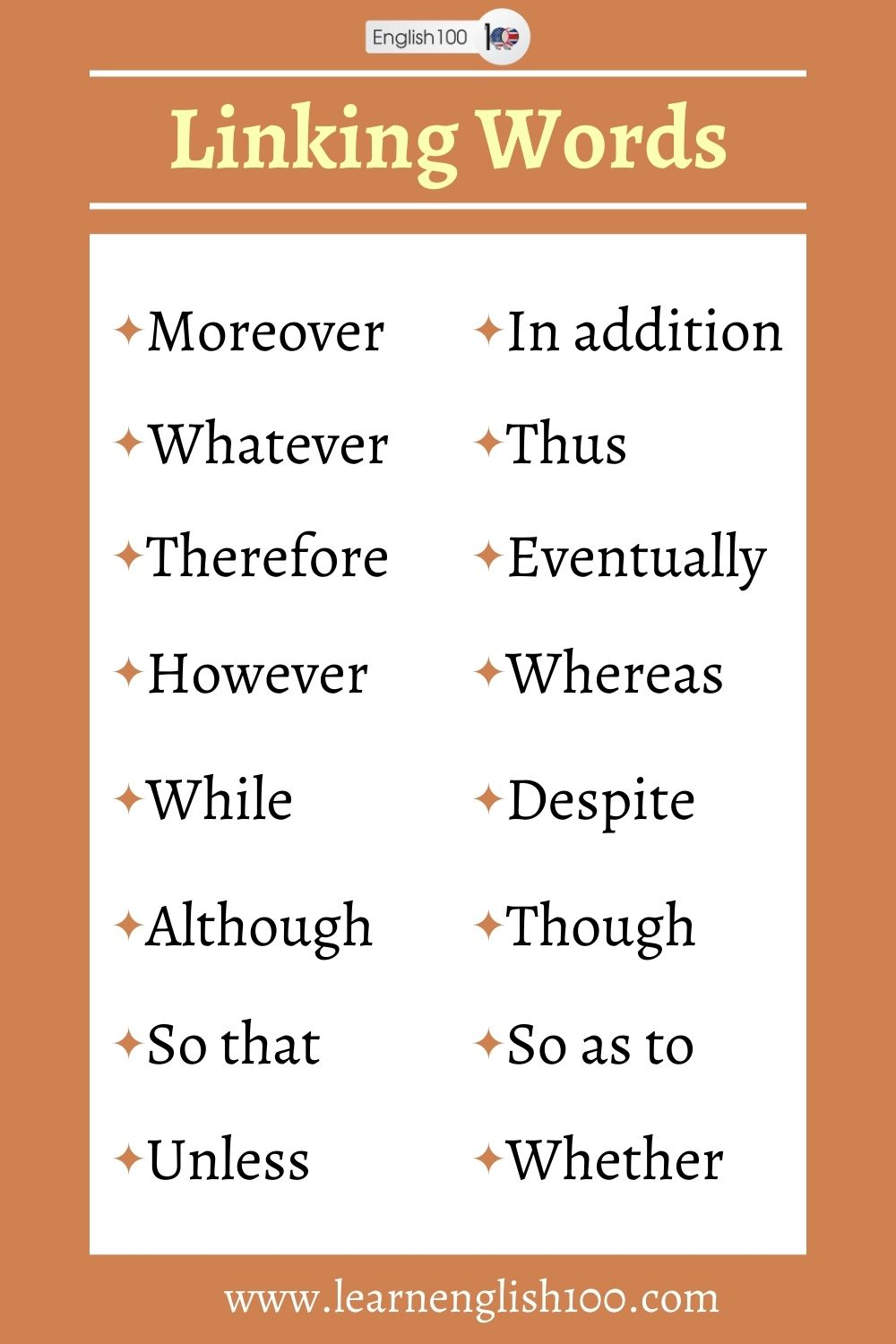
Linking Words
In the realm of writing, achieving clarity and coherence is paramount. One indispensable tool in accomplishing this is the strategic use of linking words. Often referred to as “linkers” or “transitional words,” these linguistic connectors , linking words, play a crucial role in guiding readers through the text. In this article, we will explore the world of linking words, uncovering their importance, and examining their diverse applications in writing.
The Significance of Linking Words
Linking words serve as linguistic signposts that help readers navigate the text smoothly. They establish logical connections between sentences, paragraphs, and ideas, making the text flow cohesively. By using linking words effectively, writers can enhance the readability and comprehension of their content.
Linking words help link sentences to other sentences and paragraphs to other paragraphs. These linking words help to: increase cohesion in your writing by connecting your ideas. add clarity to your writing so you say exactly what you want to say. 1
Linking words usage
ADDING IDEAS
We need to present more than one argument to withstand the attacks on our points. To add more points, we have to possess the power to add them.
Moreover
Also
Besides
In addition
What’s more
Not only … but also
As well as
And
Furthermore
OPINION:
To present our opinions which should be built on Facts.
In my opinion
As far as I’m concerned
To my mind
It seems to me that…
CONSEQUENCE
In order to illustrate the consequences of a certain event or action.
As a result
Thus
So
Therefore
As a consequence
Eventually
That’s why
CONTRAST
Presenting a contrast can be very helpful in building your case.
However
But
Yet
Whereas
While
On the one hand
On the other hand
CONCESSION
Transform the negative into a positive aspect through the power of concession.
Even though
But for
Despite
Apart from
Although
Though
PURPOSE
Be clear in regard to your purpose in whatever you do and especially in writing. Be precise!
To
So that
So as to
In order to
CONDITION
To add a condition to your presentation, use any of the following words.
As long as
Unless
If
Provided that
Whether
CHOICE
To present the audience with a choice, we’ll help you through this great list of words that’ll make clear that not all options are on the table.
Or
Whatever
Whoever
Neither … nor
Either … or
Words can connect people from different places, or bind them together in a shared experience that brings meaning to our lives. There is something particularly powerful about linking words—it gives a new sense of purpose and a fresh start for what was once an idea.
FAQ
What are the main linking words?
Linking words, also known as transitional words or connectors, play a crucial role in creating coherence and flow in writing. Here are some main categories of linking words:
1. Sequential
Firstly, Secondly, Thirdly: Used to enumerate points or steps.
Next, Then, Afterward: Indicate the order of events or steps.
Meanwhile, In the meantime: Show simultaneous actions or events.
2. Cause and Effect
Because, Since: Introduce reasons or explanations.
Therefore, Consequently, Thus: Denote a result or effect.
So, As a result: Indicate a consequence.
3. Contrast and Comparison
However, Nevertheless, On the other hand: Introduce a contrasting idea.
Similarly, Likewise: Indicate a similarity or agreement.
In contrast, Conversely: Highlight differences.
4. Addition and Amplification
Furthermore, Moreover, Additionally: Signal an additional point or argument.
For instance, For example, Such as: Introduce specific examples.
In addition to, Not only…but also: Emphasize the importance of additional information.
5. Time and Sequence
Afterward, Subsequently: Indicate a chronological sequence.
Simultaneously, Meanwhile: Signify events happening at the same time.
Finally, Lastly: Mark the end or conclusion of a series of events.
6. Concluding and Summarizing
In conclusion, To sum up: Signal the end of a discussion.
To summarize, In summary: Provide a brief recap of key points.
7. Emphasis
Indeed, Certainly, Undoubtedly: Emphasize the importance or certainty of a point.
In fact, Specifically: Provide additional emphasis or detail.
8. Condition
If, Unless: Introduce conditions or possibilities.
Provided that, Assuming that: Specify conditions for something to happen.
9. Purpose
So that, In order to: Indicate the purpose or intention behind an action.
10. Contrast
While, Whereas, Although: Highlight contrasting ideas or conditions.
How do linking words work?
Linking words, also known as transitional words or connectors, work by establishing relationships between different parts of a text, such as sentences, paragraphs, or ideas. They serve as bridges that guide readers through the content, making the text more coherent, logical, and readable. Here’s how linking words work:
- Connecting Ideas
- Sequencing
- Showing Cause and Effect
- Expressing Contrast
- Adding Information
- Emphasizing Points
- Summarizing
- Showing Time and Sequence
- Providing Conditions
- Expressing Purpose
What is the role of linking words in a paragraph?
Linking words play several crucial roles in a paragraph:
Coherence and Flow: They act as bridges between sentences and ideas, ensuring that the paragraph flows smoothly. They help readers navigate from one point to the next, creating a coherent and logical progression of thoughts.
Unity: They help maintain unity within a paragraph by connecting related ideas and preventing the text from feeling disjointed or fragmented. They reinforce the central theme or topic of the paragraph.
Transitions: They provide transitional cues that signal shifts in focus, direction, or perspective within the paragraph. They alert readers to changes in the narrative, argument, or topic.
Emphasis: They can emphasize certain points or ideas within the paragraph, drawing the reader’s attention to key information. They help convey the writer’s intended emphasis or importance.
Support and Explanation: They introduce examples, evidence, or further explanation, bolstering the writer’s arguments or claims. They help clarify and expand upon the paragraph’s main ideas.
Contrast and Comparison: They enable writers to express contrasting or comparative relationships between ideas. They help highlight differences, similarities, or opposing viewpoints within the paragraph.
Chronological Order: They assist in organizing information in chronological or sequential order, allowing readers to follow a timeline of events or steps.
Concluding Thoughts: They can signal the conclusion of a paragraph or the transition to the next one, summarizing the main points or wrapping up the discussion.
In summary, They serve as essential tools for writers to structure their paragraphs effectively and facilitate reader comprehension. They enhance the overall quality of written communication by ensuring clarity, coherence, and logical progression within the text. When used skillfully, linking words contribute to the readability and impact of the paragraph, making it more engaging and persuasive.
Is often a linking word?
No, “often” is not typically considered a linking word. Instead, “often” is an adverb that is used to indicate the frequency or regularity of an action or event. It provides additional information about the verb it modifies.
For example:
She often visits her grandparents.
He often goes for a run in the morning.
Linking words, on the other hand, are words or phrases that connect different parts of a sentence or text to establish relationships, transitions, or coherence between ideas. Examples of linking words include “however,” “therefore,” “in addition,” “although,” “because,” “for instance,” and many others. These words are used to link and clarify relationships between sentences or ideas within a paragraph or text.
To conclude, in the world of writing, linking words are indispensable tools for creating well-structured, coherent, and reader-friendly content. By strategically incorporating these linguistic connectors, writers can guide their readers smoothly through their text, ensuring clarity and comprehension. Whether you are crafting a narrative, an argumentative essay, or any form of written communication, mastering the art of linking words will undoubtedly enhance your writing prowess and leave a lasting impression on your audience.
References:
